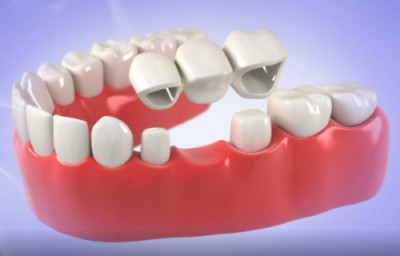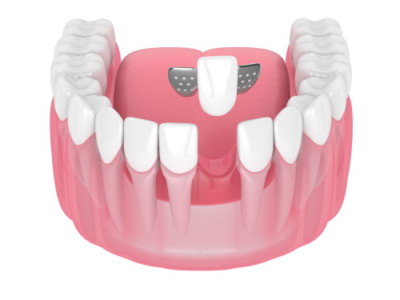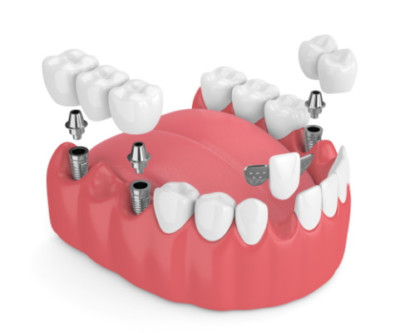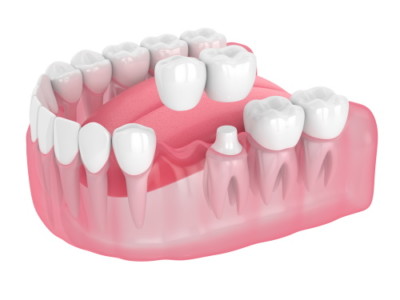Contents: Types? | When are Bridges used? | How much it costs? | Appointment | FAQs
Dental bridges are fixed dental devices that are used to restore lost teeth by utilizing the healthy teeth on each side of the gap for support. The teeth that anchor the bridge are referred to as abutments, while the teeth that fill the gap are referred to as pontics. In comparison to ordinary removable dentures, bridges are permanently attached to the teeth and can be removed only by a dentist when necessary.
Types of Tooth Bridge
Dental bridges are classified into four primary categories:
Traditional

Traditional bridges are made up of fake teeth that are secured in place by dental crowns that are glued to the abutment teeth. A conventional bridge is the most common type of bridge and is utilized when both sides of the gap have natural teeth.
Cantilever
The cantilever is a dental bridge similar to a traditional bridge but the pontic in this type is held by a dental crown cemented onto the abutment tooth. This kind of bridge requires only one natural tooth adjacent to the missing tooth gap to function.
Maryland

The concept of a Maryland bridge is similar to a typical dental bridge in the sense that the prosthetic tooth is attached to the teeth of either side of the gap to create a perfect smile. Unlike standard dental bridges, which utilize dental crowns on the back sides of abutment teeth, Maryland bridges utilize a metal or porcelain framework that is attached to the backs of the abutment teeth. Maryland bridges are only appropriate when a natural tooth exists on either side of the gap created by one missing tooth or more teeth.
Implant-supported

This kind of bridge is constructed entirely of dental implants, rather than crowns or frames. Typically, one implant is implanted surgically for each missing tooth, and these implants serve to secure the bridge in place. If one implant is not possible for each tooth, a pontic may be placed between 2 implant-supported crowns.
Why do I need a tooth bridge restoration?
When a permanent tooth falls out, the surrounding teeth may drift into the gap, causing them to tilt and become lost themselves, setting off a cascade of further issues. The teeth on the nearby jaw can also shift, affecting the bite and placing stress on other teeth and jaw joints. These teeth are also more prone to decay due to their difficulty to clean. Additionally, the jaw bone can shrink, causing sunken cheeks and distorted lips. A bridge replaces that missing tooth or teeth and keeps these things from happening, and allows you to smile with a nice set of teeth.
Pros and Cons of Bridgework
Now that you know the different types of bridges and how it works. Let us get to know this treatment better by evaluating its pros and cons:
Advantages
Bridges are more affordable than implants
Dental bridges are less intrusive than dental implants and do not require as much precision during installation as dental implants do. The cost is another concern when getting into implants and bridges are cheaper than dental implants.
Bone grafting is not needed
If you’ve lost a tooth or more for quite some time, the jawbone that once held the tooth in place may have already resorbed. Bone grafting is a surgical treatment that entails the placement of bone pieces (artificial or animal bone) to fortify the jawbone. Dental implants will need bone grafting, but in dental bridges, it is not needed.
Better than Overdentures
Dentists normally recommend bridges over dentures especially if the patient has many healthy teeth left. The healthy teeth anchor it to the bridges, unlike dentures which need to be anchored to the gums using a temporary sealant which is not always that secure.
Quicker to put in and heal from than other options
Bridges are easier to install compared to dental implants as it does not need bone grafting. Even if only a few implants are required to secure the bridge, this procedure is still quicker than obtaining more implants.
Disadvantages
Pontic teeth issues
The damage to the abutment teeth can affect the bridge. When the abutment teeth aren’t that strong enough to support the bridge, the bridge can collapse. Additionally, the abutment teeth may become weak as a result of this treatment and will need to be substituted with implants.
Unfit Crowns
When crowns become loose, bacteria may enter the tooth and cause decay. The crowns may affect the structure of the teeth and could affect your bite.
Dental bridge cost
Procedure
Traditional bridges are made of two crowns, and artificial teeth located at the center that will replace the missing tooth. The crowns and artificial teeth can be made of gold, alloy, porcelain, and/or a combination of materials and are made in the laboratory in one piece.
The dentist shapes the teeth on each side of the tooth in preparation for crown placement.
Following that, the dentist cements the dental bridges into place in the patient’s mouth.
Recovery and Aftercare
With proper care and maintenance, you can make the crowns last for 15 years or longer. Here are some ways you can take care of your dental bridge:
- Brush your teeth twice a day for two minutes. Make sure that you do not forget to brush your bridge.
- Floss in between the bridge and gums to remove any oral bacteria that may have accumulated which can cause diseases. Your dentist or dental hygienist may be able to show you the correct way to floss your teeth.
- Use antiseptic mouthwash to get rid of germs around the tissues in and around the dental bridge.
- Visit your dentist regularly for checkups.
How much does Teeth Bridge Cost?
The projected cost of a dental bridge at Harbor Smiles is between $1,500 to $5,000; depending on the kind of bridge chosen. Typically, a traditional dental bridge costs between $2,000 - $5,000 for a pontic and crown for each abutment tooth. For one pontic, Maryland tooth bridges cost between $1,500 and $2,500.
This is a feasible option because dental insurance does cover tooth bridges. The cost of an all-porcelain bridge is more than that of a porcelain-fused or metal bridge.
Dental Bridges Nearby
Affordable Advanced expertise in fixed teeth restorations
A dental bridge is the finest option once you’ve lost one or several teeth. Set an appointment today and discover why our patients Huntington Beach, CA are smiling very confidently. If you live in the area, we would gladly respond to questions you may have about this procedure, the insurance companies we accept, or anything else. Don’t spend another day hiding your smile.
FAQs to fill gap due to missing tooth
How long does a bridge last?
Dental bridges typically last between five and fifteen years and have a general lifespan of ten years. How long dental bridges survive is determined by your oral hygiene routines and the bridges' care. Dr. Manali Patel DDS will ensure the longevity of your dental bridges.
Is a tooth bridge permanent?
Fixed bridges are cemented permanently to the surrounding teeth and are not removable. They are attached using a special dental cement to keep them in place. It can also be attached as an implant-supported prosthetic. The removable bridge can be used when there is a large gap or it doesn't have healthy teeth to support a fixed bridge. Harbor Smiles will ensure that the dentures you receive are of the greatest quality. Meet Dr. Manali Patel DDS.
Does getting a bridge hurt?
No, in most cases it isn’t painful as a local anesthetic will be given before the anchor teeth are prepared and the bridge is placed over them.
Fixed Bridge Near Me
When picking a dentist, it is critical that they are located near your home or place of employment, especially if you want to save significant time and money. There may be a few treatments or follow-up appointments along with your routine visits later; thus, having a dental office nearby makes appointments more convenient. Furthermore, seek out a dentist that has a stellar reputation for dental bridges. Contact us.
Schedule a complimentary appointment to get new teeth restorations.
Sources:
- Gaviria L, et al. (2014). Current trends in dental implants
- ‘A bridge too far’–the negative impact of a bridge prosthesis on gingival health and its conservative management (2013)
https://doi.org/10.1038%2Fsj.bdj.2013.877
Related Posts:

